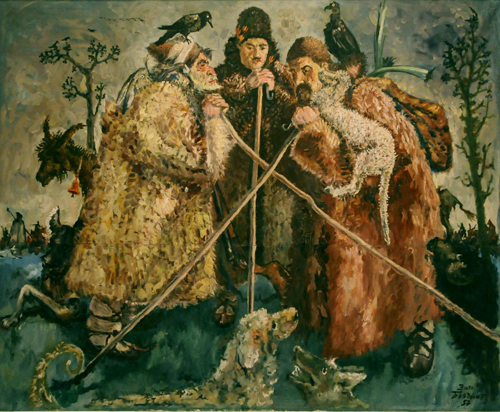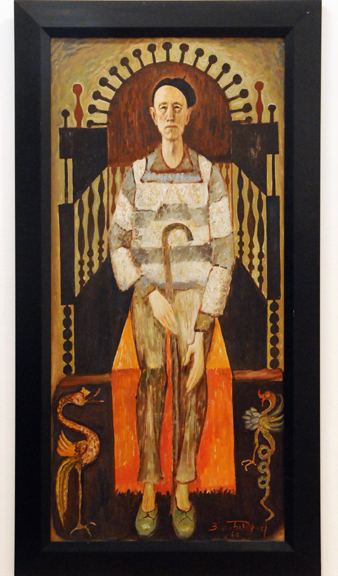 6
6
If you happen to take a walk along the meandering cobbled streets of the Old Town of Plovdiv you cannot possibly miss the house of Dr Stoyan Chomakov in Saborna St. built in 1860 in the National Revival style. Over time it was the residence of Tsar Ferdinand, and later an orphanage, a tobacco storehouse and a library. In 1984 the house was transformed into a museum of a Bulgarian artist of genius, Zlatyu Boyadzhiev. He was born on 22 October 1903 in the village of Brezovo, in the Plovdiv region, and died at 72. Village life was central to his works. He graduated the National Academy of Art in Sofia and then became a teacher in Plovdiv. More about the great painter from the director of the Zlatyu Boyadzhiev museum-house, Sevlia Todorova:
 „The first creative period of the artist that went on from 1932 to 1951 was in tune with the classical and neoclassical styles. He joined various collective exhibitions and got a few good reviews for his work. In 1939 he went on a trip to Italy that influenced his method. In that country he came in touch with pre-Renaissance and Renaissance art. During his earliest period the artist explored the classical and icon-painting techniques clearly displayed in his work Diptych. In other pieces he used techniques aligned with expressionism, and the works from his Brezovo cycle are influenced by 16-17 c. Flemish art.”
„The first creative period of the artist that went on from 1932 to 1951 was in tune with the classical and neoclassical styles. He joined various collective exhibitions and got a few good reviews for his work. In 1939 he went on a trip to Italy that influenced his method. In that country he came in touch with pre-Renaissance and Renaissance art. During his earliest period the artist explored the classical and icon-painting techniques clearly displayed in his work Diptych. In other pieces he used techniques aligned with expressionism, and the works from his Brezovo cycle are influenced by 16-17 c. Flemish art.”
The glory of Zlatyu Boyadzhiev grew. Apart from fine art he also engaged in applied art. His workload increased when he started a project for the decoration of the Nitrogenous Fertilizers Plant in Dimitrovgrad, Southern Bulgaria, explains Sevlia Todorova:
 „In 1951, at age 48, Zlatyu Boyadzhiev was stricken by a brain stroke that paralyzed his right hand. He lost his speech ability and could no longer read. During his illness and recuperation he was firmly supported by wife Tsena. She helped him in the efforts to talk again and to start writing with his left hand. Little by little, from words he switched to sketches and later - on to the oil technique.”
„In 1951, at age 48, Zlatyu Boyadzhiev was stricken by a brain stroke that paralyzed his right hand. He lost his speech ability and could no longer read. During his illness and recuperation he was firmly supported by wife Tsena. She helped him in the efforts to talk again and to start writing with his left hand. Little by little, from words he switched to sketches and later - on to the oil technique.”
In 1953 Zlatyu Boyadzhiev started painting landscapes of Old Town Plovdiv again.
„The artist's style was fully transformed. His wife remarked that he switched to a different color range. During his first period he was focused on complex color combinations, while during the second one he used mostly warm, bright tints and displayed naivety of style. Instead of classical painting without even a trace of the brush, he started to use a broken, expressive line and layering of paint, which is not typical of the first classical period, but rather of impressionism.”
Late artist Ioan Leviev however, opposed the division of Zlatyu Boyadzhev's work into periods. His interview is kept at the Bulgarian National Radio Golden Audio Archives:
„This is only one artist Zlatyu Boydzhiev - before and after the brain stroke. Once he had to switch from the right to the left hand, his art became more nervous and closer to Van Gogh painting. But if you explore his works, you will come across the same spiritual charge and message coming straight from the village and earth.”
One remarkable piece by Zlatyu Boyadzhiev is The Batak Massacre. It took the painter about 2 years before the brain stroke to paint the canvas. The final strokes though were added after the stroke. There is another work that is telltale of Zlatyu Boyadzhiev's drama and it is a self-portrait, Sevlia Todorova says:
„His Self-Portrait from that period is remarkable. In it his message is about the hard creative path that he traveled from the virtuoso skill to paint with the right hand to expression with the left hand. In this self-portrait painted frontally, Zlatyu Boyadzhiev recreated his left and right halves in different styles. This was his way to tell us that regardless of hardships, art invariably empowers and inspires.”
English Daniela Konstantinova
Photos: BULFOTO and BGNESThe Bogdan Khmelnitsky Melitopol State Pedagogical University, together with the Shumen University "Bishop Konstantin Preslavsky", organize the ninth International Bulgarian readings "Youth in Science without Borders", which will be..
"Bulgarians decorate the world," tells us Emilia Juеcker, who has been living in Germany for decades. The diversity of our cultural traditions, literature, and folklore is at the heart of the seventh annual meeting "Bulgarian Speech, Music, Colors and..
The second edition of the Festival of Bulgarians and Descendants of Bulgarians in Argentina will be held on November 30 at the San Juan Bosco School in the Argentine city of Comodoro Rivadavia. “This Saturday, our beloved society will welcome..
The Bogdan Khmelnitsky Melitopol State Pedagogical University, together with the Shumen University "Bishop Konstantin Preslavsky",..
"Bulgarians decorate the world," tells us Emilia Juеcker, who has been living in Germany for decades. The diversity of our cultural traditions,..
The second edition of the Festival of Bulgarians and Descendants of Bulgarians in Argentina will be held on November 30 at the San Juan Bosco School in..

+359 2 9336 661
